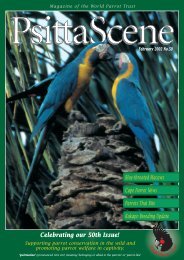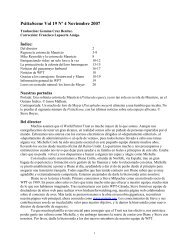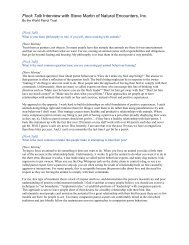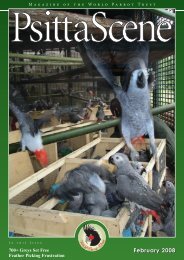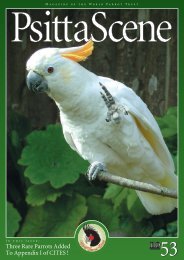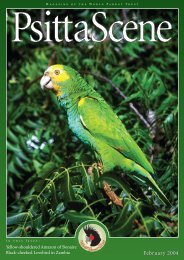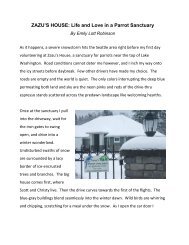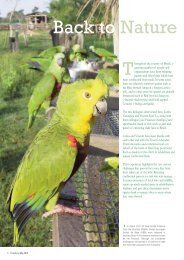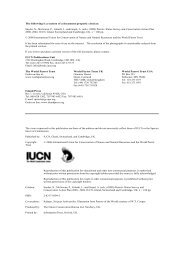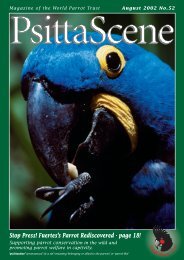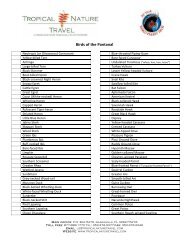Download - World Parrot Trust
Download - World Parrot Trust
Download - World Parrot Trust
You also want an ePaper? Increase the reach of your titles
YUMPU automatically turns print PDFs into web optimized ePapers that Google loves.
unusual in this regard. Different<br />
individuals within a population<br />
bear fruits asynchronously; in<br />
the home range of a Vulturine<br />
<strong>Parrot</strong> there could easily be at<br />
least one or two trees in fruit at<br />
any one time. Thus, if a<br />
frugivore were to specialise on<br />
just a few food plants, figs<br />
would be the best group to<br />
specialise upon.<br />
Young Vulturine <strong>Parrot</strong>s about 1 year old. These birds were acquired from local hunters who were taking them to the city to<br />
sell. They were hand-reared and released back to the wild. We kept a perch with food on the veranda of the house to which<br />
they would come for food less and less frequently. After several months they rarely came back to feed, though they would<br />
perch nearby.<br />
walled and weaker-billed birds<br />
can open them. Thus, quite<br />
possibly the figs and parrots are<br />
in a fairly tight mutualism;<br />
anything that impacts one will<br />
ultimately affect the other. The<br />
parrots need the figs for food<br />
and the figs need the parrots to<br />
put their seeds on host tree<br />
limbs. It is an example of the<br />
incredible complexity of the<br />
rainforest that highlights the<br />
need for good field research<br />
before we can fully understand<br />
how to conserve any particular<br />
species like the Vulturine <strong>Parrot</strong>.<br />
Hunted for their<br />
feathers<br />
Habitat modification and the<br />
Vulturine’s narrow diet are,<br />
however, not the only threat to<br />
the species. The bird is largely<br />
black, but the belly and wings<br />
have feathers that are bright<br />
red. These few red feathers<br />
could prove the Vulturine’s<br />
downfall because they are highly<br />
prized as trade items and for<br />
ornamentation among the many<br />
ethnic groups of New Guinea. In<br />
some areas Vulturine <strong>Parrot</strong><br />
feathers are the third most<br />
common trade item (after pigs<br />
and money). Many groups use<br />
the wing feathers, particularly<br />
the half red-half black<br />
secondaries, in their traditional<br />
headdresses. Although<br />
westernisation has diminished<br />
many customs, the people of<br />
New Guinea still maintain many<br />
of their traditions and dances,<br />
breaking out the special attire<br />
for parties (singsings), weddings<br />
and other big events.<br />
Even where Vulturine <strong>Parrot</strong><br />
feathers are not traditionally<br />
used, people still trade them,<br />
for considerable sums, to<br />
If these parrots are indeed as<br />
specialised on figs as we<br />
suspect, it would be wise to<br />
assess the effect of logging and<br />
other increasing land uses on<br />
the figs in question. Birds with<br />
narrowly specialised diets are<br />
vulnerable to forest<br />
perturbations. If the few species<br />
of fig disappear with logging,<br />
specialist Vulturines might be<br />
unable to switch to alternative<br />
foods. Dietary generalists are<br />
often more flexible in the face of<br />
habitat modification because<br />
they can switch to other,<br />
possibly less-preferred,<br />
resources that survive or<br />
establish after logging.<br />
<strong>Parrot</strong>s need figs<br />
and figs need<br />
parrots<br />
The figs Vulturines eat are<br />
hemiepiphytes, or stranglers.<br />
Hemiepiphytes have evolved an<br />
effective strategy to win the<br />
competition for light in the<br />
rainforest canopy. The seeds of<br />
hemiepiphytes must be<br />
dispersed by birds (or other<br />
arboreal / volant animals), to<br />
the limbs of other (host) trees.<br />
There they germinate and send<br />
roots down along the host tree’s<br />
trunk. So instead of starting out<br />
as a seedling in the deep shade<br />
of the forest floor,<br />
hemiepiphytes begin as<br />
seedlings high in the well-lit<br />
canopy. Eventually the growing<br />
fig encloses and “strangles” the<br />
host tree, whereupon it becomes<br />
a free-standing tree. Strangler<br />
figs are one of the hallmark<br />
images of tropical rainforests.<br />
Fig seeds that fall to the ground<br />
cannot germinate and grow<br />
upward. In fact, experts in fig<br />
evolution hypothesise that the<br />
sub-group of figs the Vulturines<br />
eat actually are evolutionarily<br />
specialised on parrot-mediated<br />
dispersal because the figs have a<br />
hard receptacle wall that parrots<br />
can open. Most figs are softneighbours<br />
who do use the<br />
feathers. Thus, as human<br />
population grows and as<br />
Vulturines are hunted out of<br />
areas, the demand is transferred<br />
to those areas where Vulturine<br />
populations are still intact.<br />
Indeed, with hundreds of small<br />
landing strips across the island,<br />
the demand for feathers can<br />
reach even the remotest part of<br />
the island. In many remote areas<br />
one of the most profitable<br />
endeavours can be the sale of<br />
live wild game and feathers<br />
because these can be flown<br />
more economically than coffee<br />
or other produce. Adult birds<br />
are either hunted directly or<br />
more commonly nest trees are<br />
cut down to capture the chicks.<br />
These chicks are then raised<br />
until their red feathers appear<br />
and then sold for a hefty price.<br />
This practice undoubtedly slows<br />
reproductive success as the nest<br />
tree is usually completely cut<br />
down or the nest chamber<br />
hacked open. If the nesting pair<br />
survives, they must find another<br />
suitable tree and excavate a<br />
chamber. Establishing a new<br />
nest would probably delay<br />
nesting for a full year because<br />
suitable trees are hard to find.<br />
The rainforests of New Guinea<br />
might be short on nest sites<br />
relative to other tropical forests<br />
because there are no<br />
woodpeckers on the island.<br />
Hunters that cut down hollow<br />
trees in order to extract cavitydwelling<br />
game exacerbate this<br />
shortage.<br />
We desperately need data on<br />
how many birds are being<br />
traded, how they are hunted and<br />
where trade skins are coming<br />
from. There is some<br />
international trade in Vulturine<br />
<strong>Parrot</strong>s, mostly out of the<br />
Indonesian side of New Guinea,<br />
but the real impact is domestic<br />
use by traditional hunters and<br />
traders. Thus the fine efforts by<br />
conservationists monitoring the<br />
international parrot trade will<br />
not unveil the extent of<br />
Vulturine exploitation and we<br />
are reduced to guessing its<br />
impact. Furthermore, without<br />
basic natural history<br />
information on diet, population<br />
densities and reproduction we<br />
will be unable to determine how<br />
vulnerable the species is even if<br />
we do obtain data on domestic<br />
trade. At the moment we cannot<br />
categorically say the species is<br />
in serious danger, nor can we be<br />
complacent that it is secure.<br />
Certainly populations have been<br />
extirpated from large areas in<br />
recent times.<br />
Management<br />
options<br />
If proper study indicates<br />
populations are indeed<br />
threatened by hunting, then<br />
there might be options for<br />
management that could both<br />
maintain populations and allow<br />
the people of New Guinea to<br />
carry on their rich cultural<br />
heritage. Possibly less<br />
destructive methods of hunting<br />
could be encouraged or<br />
alternatives to Vulturine<br />
feathers introduced to the trade.<br />
Ideally, we have the opportunity<br />
to preserve the traditional use<br />
of a wild parrot species and<br />
populations of that parrot.<br />
These two objectives are often<br />
in conflict where human<br />
populations are increasing and<br />
forest cover decreasing. Solid<br />
field research will enable us to<br />
determine how to conserve this<br />
bizarre parrot without<br />
jeopardising the diverse cultural<br />
traditions of New Guinea.<br />
PsittaScene Volume 11, No 4, November 1999 ■ 3




